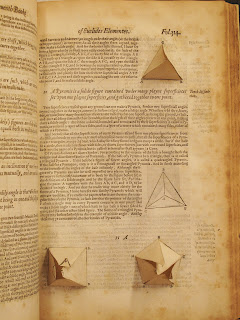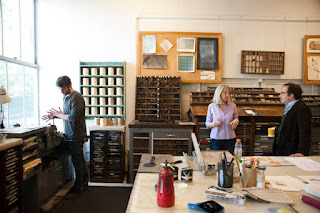For the contemporary fine press printer, paper presents a
host of difficulties. In my own work I have vacillated between emphasizing and
de-emphasizing the substrate, from commissioning self-consciously handmade papers
to using the most unassuming commercial sheets. In the end, neither has fully satisfied
me: both styles of paper embody a physical sub-narrative that is often at odds
with both my printing æsthetic and the primary narrative of my books. Ideally, these are the attributes that I
am looking for in a handmade sheet: good printability of both type and images requiring
a minimum of pressure; light surface sizing; a handsome drape when bound; and a
pleasing “rattle” or “snap” when handled. The printability and snap are, in
turn, related to an inner density, a hardness that encourages ink to release
and lines to stay crisp.
There is a distressing softness to many contemporary hand- and
mould-made papers and this softness creates problems when making a fine book: soft
papers require more pressure for ink to transfer; the additional pressure
increases paper stretch which makes tight registration more difficult or
impossible; the paper damages easily in the printing as well as during and after
binding; and, in an effort to compensate for these qualities, many softer papers
are made too thick, which interferes with the action of the bound book. From my
brief collaborations with Dieu Donné Papermill in the 90s I attribute the
relative softness or snap of a paper to the fiber choice and beating time used
to prepare the pulp. My assumption, therefore, has been that my ideal paper formula
would be found by tweaking these factors until I got them right.
When I posed these various concerns to Tim Barrett at the
University of Iowa his take was quite different than mine. As detailed in my
earlier blog post on Iowa City, Tim suggested that the sizing is a critical
feature in determining both the snap and the longevity of a paper. When I
brought up the negative impact of surface sizing on printability Tim responded
that there is an historical precedent for me to add sizing
after printing. To test his theory, I sent Tim some prints on Velke
Losiny paper from which I had soaked most of the sizing. Tim re-applied a 2.5% sizing
solution to the sheets and, to my surprise, the process not only added considerable
snap to the paper, it did not damage the color or quality of the prints. This
approach—adding sizing after printing—would be a tempting solution to the issue
of snap were it not for two critical problems: 1) the thought of putting my
printed sheets through an additional process would run the risk of driving me
mad with worry, and 2) although post-press sizing addresses the æsthetic aspect
of paper snap in the finished book, it does not address the functional purpose
of snap
during printing. Regardless
of when I size a paper, from the perspective of printing I need to first deal
with that paper’s fiber and its preparation.
Paper can be made from many different fibers but the primary
ones for my consideration are cotton linters, cotton rag, linen rag, flax, and
abaca. To oversimplify: the
longer you beat fibers the more rattly, translucent, and hard the resulting
paper will be. This is especially extreme in linen, flax, and abaca pulps. With any
fiber there is a threshold beyond which the positive aspects of longer beating
become detrimental to the finished sheet; too much snap or
hardness produced by longer beating can impede the printability or action of
the paper, and the more translucent a paper is the fewer printing options it
can accommodate.
To further complicate matters, I have come into this project
with an (unsubstantiated) bias against the use of cotton linters, a bias
informed largely by the fact that the historical handmade papers I most admire
were made using linen rag. When you compare the 100% linen rag Kelmscott papers
that the Batchelor mill made for William Morris to many sheets made from cotton
linters, there is no real comparison. While some cotton papers are sensorially
evocative or have a tantalizing drape, linen papers are distinguished by an
inner hardness that naturally lends itself to letterpress printing. The ink wants to transfer from the printing
surface to the paper. This does not necessarily mean, however, that using 100%
linen rag is the solution to my paper dilemma. For instance, I recently
acquired a small stack of Batchelor’s Crown and Sceptre paper and, while the
paper does indeed cry out for printing, it does not cry out for my printing. The paper’s inner hardness requires
that, for proper dynamics, the sheets be comparatively thin. The printing
techniques I have been using in recent years would show through too much for the
Batchelor paper to be a good choice for one of my books. Instead, my hunch has
been that I need a paper composed of both linen and cotton pulp, counterbalancing the native hardness of linen with the flexibility of cotton.
As a first step in testing this hunch I contacted my friend
Mina Takahashi and asked if she would spend a couple of days experimenting with
me on her farm. I first met Mina in 1990 at a book arts conference in New York
City. She was the freshly-minted Executive Director of Dieu Donné Papermill and
I was manning (or boy-ing) the table of the New College of California Press. I
had been printing for about six months and I spent a good deal of the
conference quizzing Mina about Dieu Donné’s papers and mauling the samples she
had to show. Shortly after moving back to New York in 1993, I took an
introductory papermaking class at Dieu Donné and quickly became a kind of
hanger-on at the mill. Although papermaking didn’t stick with me, Mina and I
have been collaborating on one thing or another ever since.
About four years ago, Mina and her husband Marco Breuer
moved to Oxford, New York to set up a self-sustaining, organic farm. Since then
the enterprise has grown to involve fifty chickens, a few ducks, a milk cow,
two calves, three draft horses, a shitake mushroom farm in the pinetum,
planting fields, and a small paper studio tucked in a corner of the dairy barn.
Like all of the people we have visited on this trip, I have been trying
unsuccessfully to get to Oxford for years. Unlike the other people we have
visited, though, the only way to see both Mina and Marco is to go to them—as an
operating farm there is too much to be done for them both to leave the property.
In advance of our visit I sent Mina some samples of
different papers that possessed qualities I wanted to pursue or avoid and we
had a few discussions about possible fiber choices. Wanting to keep things
relatively simple we decided to experiment with linen rag, an old cotton
tablecloth, Twinrocker 89 (a sheet-formed, semi-macerated cotton rag), and Twinrocker
290 cotton linters. The fibers were prepared as follows:
Cotton Tablecloth:
1)
Washed with Borax
2)
Cut into ½” squares with rotary blade
3)
Soaked for two days
4)
Beaten for total of six hours
5)
3% solution of calcium carbonate added
Linen Rag Selvage
1)
Cut and soaked overnight
2)
Cooked in 20% soda ash for one and a half hours at strong
boil followed by three hours simmer; rinsed and soaked overnight
3)
Beaten for a total of three and a half hours
4) 3% solution of calcium carbonate added
Twinrocker 89
1)
Soaked for one hour
2)
Beaten for a total of one and half hours
3)
3% solution of calcium carbonate added
Twinrocker 290 Cotton Linters
1)
Soaked for thirty minutes
2)
Beaten for thirty minutes
3) 3% solution of calcium carbonate added
To describe Mina’s paper studio as small is a bit of an exaggeration,
tiny is more accurate. The room is
large enough to accommodate the beater, vat, press, and small table required to
make paper, but two people at work would push the space to its limits. So, prior
to our arrival, Marco put up a shade tent on the lawn to give us a little extra
room to pull and couch the sheets en plein air. The last time I pulled a sheet of paper was in 1994 in the Dieu Donné studio on Crosby Street, a cramped, damp place lodged between sweat shops on the edge of Chinatown. By contrast, the set up in Oxford was an Arcadian dream, made only slightly less idyllic by the constant chores upon which the farm depends (chores that Annie gladly assisted in and to which I, by contrast, applied my lifelong maxim: stay out of a worker's way).
I have never, since my first dabbling at Dieu Donné, seriously entertained making my own paper. I already have enough to concentrate on doing and, in thinking about the aforementioned damp New York City loft, it has been hard for me to see the attraction of dipping in and out of a cold vat of water all day. For the first time in Oxford I understood why people would go through the trouble. As you rock the mould from side to side and front to back, there is a moment when, all of a sudden, you see the sheet form. The dissolute fibers interlock and, in the suspended water trapped in the deckle, the porous congregate of fiber becomes a contiguous whole. It is a small epiphany that tells you when to stop moving and it is charged with the same creative excitement I experience pulling a good print. It was almost inspiring enough to make me set up a paper studio....
Over the course of two days Mina and I pulled sheets using a variety of fiber combinations and, true to my suspicions, I felt immediately drawn to the sheets composed of Twinrocker 89 and Linen Rag. A few weeks after returning, Mina shipped me the dried sheets for printing tests. On each paper I printed a solid area of color, a halftone, large and small type (all from polymer plates), and a form of foundry type. No self-evident IDEAL PAPER made itself known and, at best, my tests were inconclusive. The sheets made with linen in them required, in general, less ink and revealed less show through than the purely cotton sheets. The sheets made with 75% Twinrocker 89 and 25% Linen had the added pleasing qualities of snap and drape. Despite these initial results, the only way to test them will be to commission a larger making of sheets and go to town.
*I realize that some people might take issue with me referring to Oxford, New York as the mid west but I think there is a reasonable argument that the eastern border of the mid western United States is the Hudson River.

Mina and I in the studio.
The vat and couching table.
Forming the sheet.
Couching the sheet.
Cleaning the deckle with dog and horse.
The stack.
Annie assisting Marco with watering.
Mina and I transferring the pressed sheets to the drying system.
Comparing notes over much-deserved gin and tonics.



















































